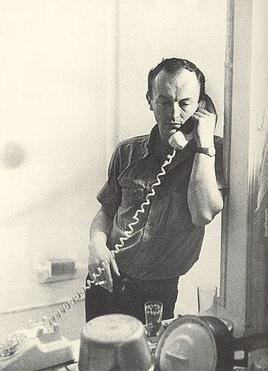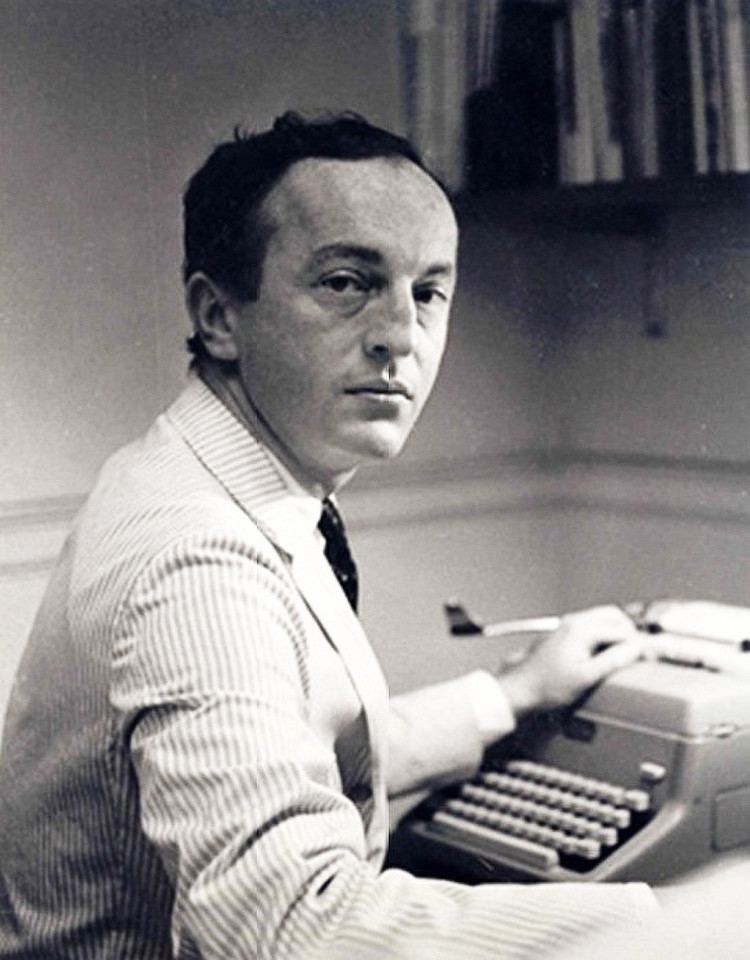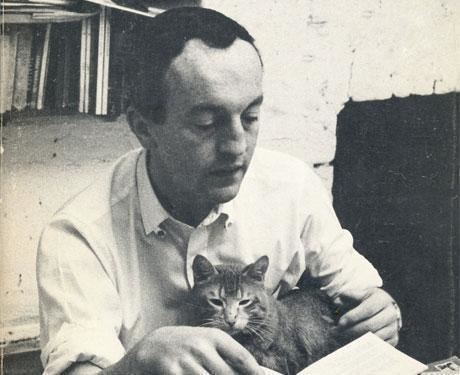Occupation Poet, art curator Genre American poetry | Citizenship USA | |
 | ||
Alma mater Harvard University (B.A. English, 1950)University of Michigan (M.A., English Literature, 1951) Parents Russell Joseph O'Hara, Katherine O'Hara Books Lunch Poems, The Collected Works of, Meditations in an Emergency, Selected poems, Poems retrieved Similar John Ashbery, Kenneth Koch, Larry Rivers, James Schuyler, William Carlos Williams | ||
My heart by frank o hara poetry reading
Francis Russell "Frank" O'Hara (March 27, 1926 – July 25, 1966) was an American writer, poet and art critic. Because of his employment as a curator at the Museum of Modern Art, O'Hara became prominent in New York City's art world. O'Hara is regarded as a leading figure in the New York School—an informal group of artists, writers and musicians who drew inspiration from jazz, surrealism, abstract expressionism, action painting and contemporary avant-garde art movements.
Contents
- My heart by frank o hara poetry reading
- Having a coke with you by frank o hara poetry reading
- Life
- Poetry
- In music
- In films
- In literature
- In television
- Landmarks
- Painting
- References
O'Hara's poetry is personal in tone and in content and has been described as sounding "like entries in a diary". Poet and critic Mark Doty has said O'Hara's poetry is "urbane, ironic, sometimes genuinely celebratory and often wildly funny" containing "material and associations alien to academic verse" such as "the camp icons of movie stars of the twenties and thirties, the daily landscape of social activity in Manhattan, jazz music, telephone calls from friends". O'Hara's writing sought to capture in his poetry the immediacy of life, feeling that poetry should be "between two persons instead of two pages."

The Collected Poems of Frank O'Hara edited by Donald Allen (Knopf, 1971), the first of several posthumous collections, shared the 1972 National Book Award for Poetry.

Having a coke with you by frank o hara poetry reading
Life

Frank O'Hara, the son of Russell Joseph O'Hara and Katherine (née Broderick), was born on March 27, 1926, at Maryland General Hospital, Baltimore and grew up in Grafton, Massachusetts. He attended St. John's High School. He grew up believing he had been born in June, but in fact had been born in March, his parents having disguised his true date of birth because he was conceived out of wedlock. He studied piano at the New England Conservatory in Boston from 1941 to 1944 and served in the South Pacific and Japan as a sonarman on the destroyer USS Nicholas during World War II.

With the funding made available to veterans he attended Harvard University, where artist and writer Edward Gorey was his roommate. O'Hara was heavily influenced by visual art and by contemporary music, which was his first love (he remained a fine piano player all his life and would often shock new partners by suddenly playing swathes of Rachmaninoff when visiting them). His favorite poets were Pierre Reverdy,Arthur Rimbaud, Stéphane Mallarmé, Boris Pasternak, and Vladimir Mayakovsky. While at Harvard, O'Hara met John Ashbery and began publishing poems in the Harvard Advocate. Despite his love of music, O'Hara changed his major and graduated from Harvard in 1950 with a degree in English.
He then attended graduate school at the University of Michigan in Ann Arbor. While at Michigan, he won a Hopwood Award and received his M.A. in English literature in 1951. That autumn O'Hara moved into an apartment in New York City with Joe LeSueur, who would be his roommate and sometime lover for the next 11 years. It was during this time that he began teaching at The New School.
Known throughout his life for his extreme sociability, passion, and warmth, O'Hara had hundreds of friends and lovers throughout his life, many from the New York art and poetry worlds. Soon after arriving in New York, he was employed at the Museum of Modern Art, selling postcards at the admissions desk, and began to write seriously.
O'Hara was active in the art world, working as a reviewer for Artnews, and in 1960 was Assistant Curator of Painting and Sculpture Exhibitions for the Museum of Modern Art. He was also a friend of the artists Willem de Kooning, Norman Bluhm, Larry Rivers and Joan Mitchell.
In the early morning hours of July 24, 1966, O'Hara was struck by a jeep on the Fire Island beach, after the beach taxi in which he had been riding with a group of friends broke down in the dark. He died the next day of a ruptured liver. Attempts to bring negligent homicide charges against 23-year-old driver Kenneth L. Ruzicka were unsuccessful; many of O'Hara's friends felt the local police had conducted a lax investigation to protect one of their own locals. O'Hara was buried in Green River Cemetery on Long Island. The painter Larry Rivers, a longtime friend and lover of O'Hara's, delivered one of the eulogies, along with Bill Berkson, Edwin Denby and René d'Harnoncourt.
Poetry
While O'Hara's poetry is generally autobiographical, it tends to be based on his observations of New York life rather than exploring his past. In his introduction to The Collected Poems of Frank O’Hara, Donald Allen says "that Frank O’Hara tended to think of his poems as a record of his life is apparent in much of his work.” O'Hara discussed this aspect of his poetry in a statement for Donald Allen's New American Poetry:
What is happening to me, allowing for lies and exaggerations which I try to avoid, goes into my poems. I don’t think my experiences are clarified or made beautiful for myself or anyone else, they are just there in whatever form I can find them. . .My formal "stance" is found at the crossroads where what I know and can't get meets what is left of that I know and can bear without hatred. . .It may be that poetry makes life's nebulous events tangible to me and restores their detail; or conversely that poetry brings forth the intangible quality of incidents which are all too concrete and circumstantial. Or each on specific occasions, or both all the time.
His initial time in the Navy, during his basic training at Sampson Naval Training Center in upstate New York, along with earlier years spent at St. John’s High School began to shape a distinguished style of solitary observation that would later inform his poems. Immersed in regimented daily routine, first Catholic school then the Navy, he was able to separate himself from the situation and make witty and often singular studies. Sometimes these were cataloged for use in later writing, or, perhaps more often, put into letters. This skill of scrutinizing and recording during the bustle and churn of daily life would, later, be one of the important aspects that shaped O’Hara as an urban poet writing off the cuff.
Among his friends, O'Hara was known to treat poetry dismissively, as something to be done only in the moment. John Ashbery claims he witnessed O'Hara “Dashing the poems off at odd moments – in his office at the Museum of Modern Art, in the street at lunchtime or even in a room full of people – he would then put them away in drawers and cartons and half forget them.”
In 1959, he wrote a mock manifesto (originally published in Yugen in 1961) called Personism: A Manifesto, in which he explains his position on formal structure: "I don't ... like rhythm, assonance, all that stuff. You just go on your nerve. If someone's chasing you down the street with a knife you just run, you don't turn around and shout, 'Give it up! I was a track star for Mineola Prep.'" He says, in response to academic overemphasis on form, "As for measure and other technical apparatus, that's just common sense: if you're going to buy a pair of pants you want them to be tight enough so everyone will want to go to bed with you. There's nothing metaphysical about it." He claims that on August 27, 1959, while talking to LeRoi Jones, he founded a movement called Personism which may be "the death of literature as we know it."
He says,
"It does not have to do with personality or intimacy, far from it! But to give you a vague idea, one of its minimal aspects is to address itself to one person (other than the poet himself), thus evoking overtones of love without destroying love's life-giving vulgarity, and sustaining the poet's feelings toward the poem while preventing love from distracting him into feeling about the person."
His poetry shows the influence of Abstract Expressionism, Surrealism, Russian poetry, and poets associated with French Symbolism. Ashbery says, “The poetry that meant the most to him when he began writing was either French – Rimbaud, Mallarmé, the Surrealists: poets who speak the language of every day into the reader’s dream – or Russian – Pasternak and especially Mayakovsky, for whom he picked up what James Schuyler has called the ‘intimate yell.’” As part of the New York School of poetry, O'Hara to some degree encapsulated the compositional philosophy of New York School painters.
Ashbery says, “Frank O'Hara's concept of the poem as the chronicle of the creative act that produces it was strengthened by his intimate experience of Pollock's, Kline's, and de Kooning's great paintings of the late '40s and early '50s and of the imaginative realism of painters like Jane Freilicher and Larry Rivers.”
O'Hara was also influenced by William Carlos Williams. According to Marjorie Perloff in her book Frank O'Hara, Poet among Painters, he and Williams both use everyday language and simple statements split at irregular intervals. Perloff points out the similarities between O'Hara's "Autobiographia Literaria" and Williams's "Invocation and Conclusion." At the end of "Autobiographia Literaria," the speaker says, "And here I am, the/center of all beauty!/writing these poems!/Imagine!" Similarly, Williams at the end of "Invocation and Conclusion" says, "Now look at me!" These lines show a shared interest in the self as an individual who can only be himself in isolation. A similar idea is expressed in a line from Williams's "Danse Russe": "Who shall say I am not/ the happy genius of my household?"
In music
In First Aid Kit's song "To A Poet", there is the lyric, "But Frank put it best when he said "you can't plan on the heart"", a reference to Frank O'Hara's poem, My Heart.
In Martha's song "1967, I Miss You, I'm Lonely", the lyric, "I look at you and I am confident that I’d rather look at you than all the portraits in existence in the world, except possibly O’Hara by Grace Hartigan," references both O'Hara's poem, Having a Coke With You, and Grace Hartigan's portrait of Frank O'Hara.
In films
In the 2011 film Beastly, the lovestruck main characters read O'Hara's poem "Having a Coke with You" aloud to each other.
In literature
O'Hara is a minor character in William Boyd's 2002 novel Any Human Heart.
In television
In the season 1 episode of the HBO series Bored to Death, "The Case of the Missing Screenplay", the main character loses a screenplay written by Jim Jarmusch about the life of Frank O'Hara.
Several episodes of Mad Men (season 2) reference O’Hara’s collection of poetry, Meditations in an Emergency. The first episode shows a character reading from it over lunch in a bar (recalling O'Hara's 1964 collection Lunch Poems) as does the last episode, which uses the book's title as its episode title. In the twelfth episode, Don Draper finds his copy of Meditations in an Emergency in Anna Draper's home in California.
Landmarks
On June 10, 2014, a plaque was unveiled outside one of O'Hara's New York City residences, at 441 East Ninth Street. Poets Tony Towle, who inherited the apartment from O'Hara, and Edmund Berrigan read his works at the event.
